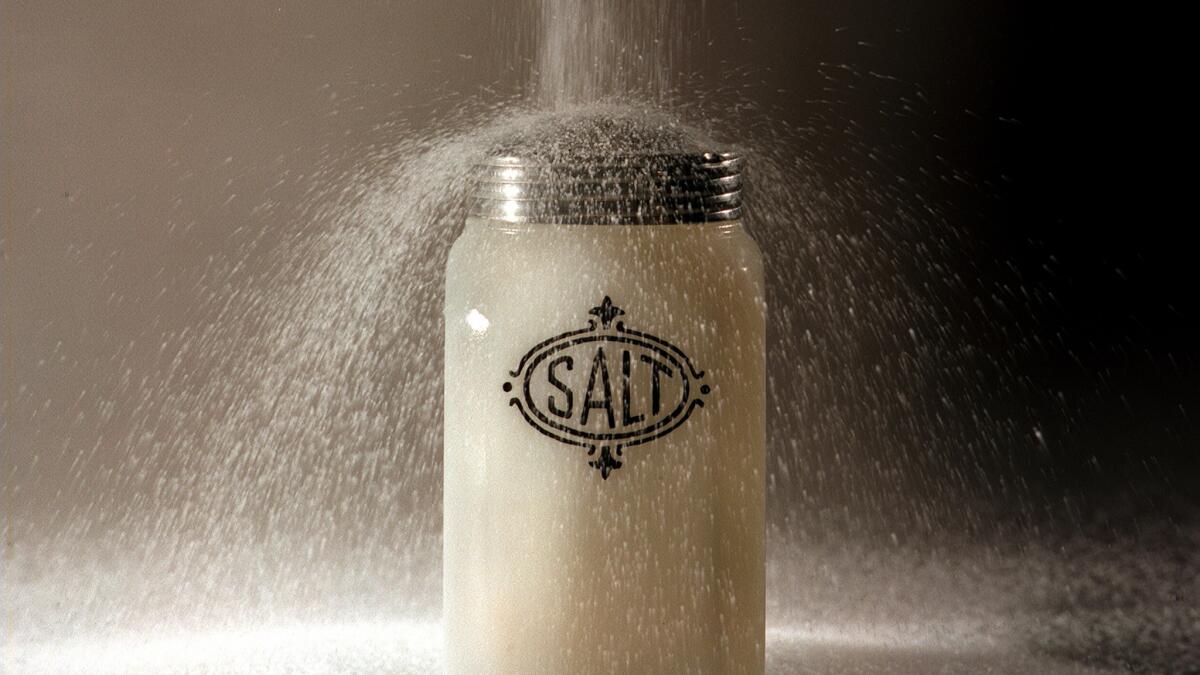Why the FDA wants food manufacturers to put one-third less sodium in their products

- Share via
Americans eat too much salt, and the government is asking restaurants and food manufacturers to help them cut back.
The U.S. Food and Drug Administration laid out its request for “voluntary sodium reduction targets” on Wednesday that would reduce Americans’ average sodium consumption by nearly one-third over a decade.
The goal is to get down to a daily maximum of 2,300 milligrams, as recommended in the government’s Healthy People 2020 targets. Today, a typical American eats nearly 1.5 times that much — 3,400 mg of sodium per day, according to the FDA.
See the most-read stories in Science this hour >>
This rampant consumption of sodium is a major reason why 1 in 3 American adults has high blood pressure, a condition that puts people at risk for heart disease (the leading cause of death in the U.S.) and stroke (which ranks fifth). In fact, high blood pressure is a factor in more than 1,000 deaths in the U.S. each day, according to Dr. Thomas Frieden, director of the Centers for Disease Control and Prevention.
The threat isn’t limited to adults — 10% of children between the ages of 8 and 17 have high blood pressure too.
Studies suggest that if Americans were to suddenly limit their sodium to no more than 2,200 mg per day, between 280,000 and 500,000 premature deaths could be avoided over a 10-year period.
“There is incontrovertible evidence of a direct, dose-response relationship between sodium and blood pressure,” Frieden wrote in an essay published Wednesday in the Journal of the American Medical Assn.
But cutting back on sodium isn’t as simple as sprinkling less salt on our fries or switching from regular to low-sodium soy sauce. That’s because 77% of the sodium Americans eat is already in their food by the time it reaches their plates, according to a study cited by the FDA. Only 6% is added while eating. (Another 5% comes from foods prepared at home, and 12% occurs naturally in foods.)
RELATED: Excess sodium intake linked to 1.65 million deaths annually
As a result, even those with the best intentions — and the most willpower — could use a little boost from the government, said Health and Human Services Secretary Sylvia Mathews Burwell.
The FDA action “is about putting power back in the hands of consumers, so that they can better control how much salt is in the food they eat,” Burwell said in a statement. The first step in the FDA plan is to reduce average sodium consumption to 3,000 mg per day within two years — a 12% decline from current levels. FDA officials said this short-term target is “readily achievable.” If Americans were to achieve it, they would prevent about 32,000 heart attacks and 20,000 strokes each year, Frieden wrote in JAMA.
Then, over the next eight years, intake should drop all the way down to 2,300 mg per day — a further 23% cut.
It sounds like a lot, but an examination of cream cheese shows that it’s doable.
Every 100 grams (about 3.5 ounces) of spreadable cream cheese sold in the United States today contains 403 mg of sodium, according to the FDA. To meet the agency’s short-term goal, cream cheese makers would need to reduce that to 380 mg of sodium. To meet the long-term goal, sodium would need to drop to 340 mg.
Australia and New Zealand are almost there already — their spreadable cream cheese contains 348 mg of sodium per 100 grams. The versions now sold in Britain and Ireland have already surpassed the FDA’s targets, with a mere 300 milligrams of sodium per 100 grams.
Indeed, Britain shows that the FDA plan can work, Frieden wrote. Britons reduced their sodium consumption by 15% in the eight years after voluntary reduction targets were set. The payoff was a roughly 40% drop in deaths due to heart disease and stroke, he wrote.
To implement its plan here, the FDA sorted foods into 150 categories — such as “flavored potato and vegetable chips,” “salami and pepperoni” and “salad dressing” — and set average sodium goals for each category. The agency also set recommended upper bounds for sodium content that apply to each individual food in a category.
As food makers reformulate their products, they should be sure not to mask the lower levels of sodium by adding more sugar, saturated fat or other ingredients that would undermine the health goals of this initiative, the FDA said in its guidance for the food industry. By allowing sodium reductions to occur in stages, the agency hopes to give consumers time to adjust their “preferences and expectations for saltiness in foods,” according to the document.
The FDA guidance does not include specific recommendations for how restaurants and manufacturers should reformulate their products to meet the new goals. Nor does it suggest limits on individual ingredients that contain sodium, such as sodium nitrite.
Foods like beets, celery and milk that naturally contain sodium are exempt from the new guidance, the FDA noted.
Not all sodium is harmful to eat (or drink). It’s a naturally occurring mineral in many such foods. Our bodies need sodium to regulate blood pressure and overall blood volume. An electrolyte, sodium also plays a crucial role in sending electrical signals between the brain, nerves and muscles.
But when it comes to sodium, it is certainly possible to have too much of a good thing. The most recent version of the Dietary Guidelines for Americans put 89% of the population in that category.
Members of the public are invited to provide feedback on the FDA’s proposed guidance over the next several months.
Follow me on Twitter @LATkarenkaplan and “like” Los Angeles Times Science & Health on Facebook.
MORE IN SCIENCE:
In the heart of Pluto, some of the youngest terrain in the solar system
Health experts question federal study linking cellphones to brain tumors
Not so dry after all: Moon’s water came mostly from asteroids, not comets, study says
UPDATES:
10:25 p.m.: This story was updated with comments made by Dr. Thomas Frieden, director of the Centers for Disease Control and Prevention, in an essay published in the Journal of the American Medical Assn.
6:16 p.m.: The story was updated with additional detail about the FDA’s plan and other background information.
The story was originally published at 3:49 p.m.







